From: Jeremy Levine and Sarah Tavel
Date: April 3, 2011
Re: Pinterest IR
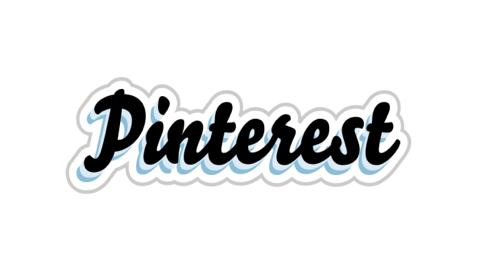
On Monday, Pinterest’s co-founders, Paul Sciarra and Ben Silbermann, will be presenting to the Partnership from our Menlo Park office.
Pinterest is a very early-stage Palo Alto-based company with a social e-Commerce web site that lets users in its community curate catalogs of products and discover products by following tastemakers.
Sarah first met the company in late 2009. At the time, Pinterest’s two founders were pursuing a strategy to build product catalog iPhone applications called “Totes” for high-end brands. They launched a limited alpha of the product to some friends and quickly noticed that users were heavily using a small social sharing feature included in the product catalogs. When they asked the users what they liked about the feature, they learned that there wasn’t a good way for users to share and curate lists of products elsewhere. They put Tote, their original product, on hold and built Pinterest to take advantage of this insight, and they launched it in Q2 2010. Despite being accessible only through a closed beta, the site’s traction has accelerated in the last few months and in February registered 1m unique visitors and 20m page views. The majority of Pinterest’s traffic comes from social channels like Twitter, Facebook and Tumblr, and almost all of the 30% that comes from Google is based on search queries that include the Pinterest brand name.
As a firm, we have thoroughly investigated theses relating to user-generated content (Yelp, Wikia, OLX), social (Playdom, Zoosk) and eCommerce (QuidSi, Onestop, Delivery Agent). We have also explored a number of different companies that play at the intersection of these three trends (“social commerce”). Pinterest is the first site we’ve found that shows demonstrable success in this area.
Thanks to Sarah’s dogged tracking of the company, we managed to get into the mix on this opportunity. We leveraged our relationship with Jimmy Wales (one of the founder’s “Internet heroes”) to grab their attention, but we are unable to mitigate the fact that they have received several term sheets. As a result, this is a very expensive deal, but we think the magnitude of the opportunity justifies the price. We have signed a term sheet to lead a $10m Series A investment at a $40m pre-money valuation inclusive of a 13% unallocated option pool.
Product
The best way to get a feel for Pinterest’s product is to try it or at least browse the site – www.pinterest.com. (If you’re interested in an invitation, email either of us.)
The site lets users in the community “pin” products from around the web either by copying URLs or using a browser bookmark in a fashion pioneered by Del.icio.us several years ago. Shortly, consumers will be able to use an iPhone app as well. Once “pinned,” products are then curated on “pin boards.” Pin boards tend to be themed. For example, Ben Silbermann, one of Pinterest’s two co-founders, created a board called “Things for my future kitchen” (http://pinterest.com/ben/things-for-my-future-kitchen), a curated catalog of different kitchen products Ben has found around the web:
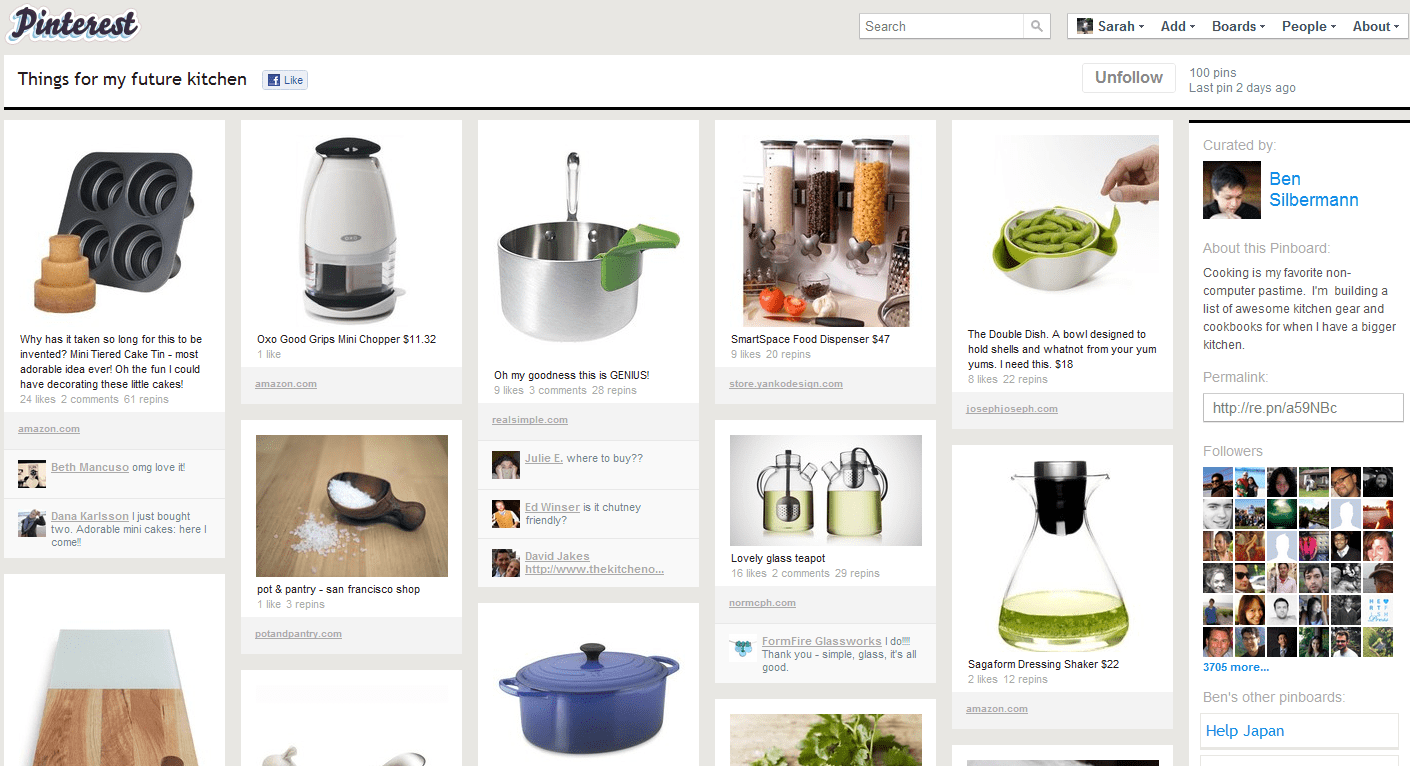
If you click on a product, you’re taken to a product page that aggregates all comments, “likes”, or “repins” (similar to “retweets” on Twitter) that other people in the community have made on that product. Similar to the company’s original social sharing functionality, the site also lets users share a product or pin board via Twitter, Facebook, email or with some embeddable javascript. Pinterest has acquired the majority of its traffic thus far from people using this functionality (check out http://twitter.com/#!/search/pinterest to see how people are sharing Pinterest on Twitter). The product page also has a link to the retailer from which the product was originally “pinned,” so if a user wants to learn more about the product or buy it, he simply needs to click on the product picture to be directed to the relevant page on a merchant’s site. There is also a side bar which features other products from the same merchant which have also been pinned by the Pinterest community. For example, this is the William Sonoma board (http://pinterest.com/source/williams-sonoma.com):
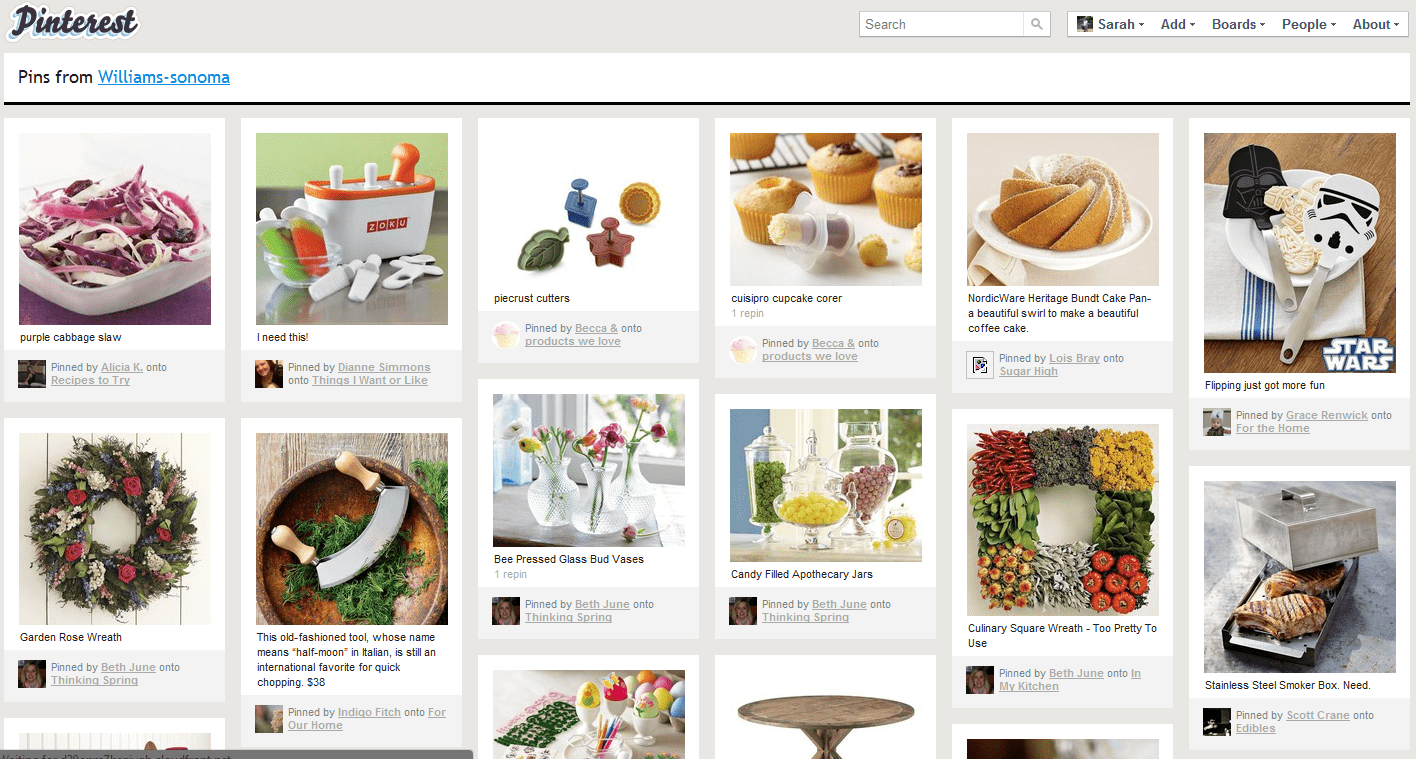
Users can follow each other, much like they do on Twitter. But you can also choose to follow a particular board instead of all the boards a user has created. For example, if a wine critic created a pin board for each of his favorite grape varietals, you could choose to unfollow the Chardonnay board if you’re not a Chardonnay fan. Boards that you follow appear on your home screen feed as updates are made.
We are viewing Pinterest through the lens of our user-generated content investment roadmap. With user-generated content sites like Yelp, only about 1% of a site’s visitors are “producers” (review writers in Yelp’s case) and 99% are merely consumers. We expect a similar ratio to exist for Pinterest as the vast majority of web users, when offered the chance to curate pin boards of products, will simply wonder, “Why on earth would I spend my time doing that?” Those same users don’t write many Yelp reviews either. Yelp had about 50 million unique visitors on its site last month, but fewer than 400,000 (0.8%) contributed any sort of content.
That said, the content “producers” are critical, and just as Yelp focused entirely on content producers in its early days, Pinterest is doing the same today. Over time, we expect the experience to improve for the content consumers, who are essentially just browsing/shopping/searching for something to buy. And eventually, Pinterest will begin to engage the merchant and manufacturer communities to monetize all of its commerce-oriented traffic.
Traction
Pinterest already has promising signs of a burgeoning community. Notably, in the last few months, the company’s traction has started to accelerate.
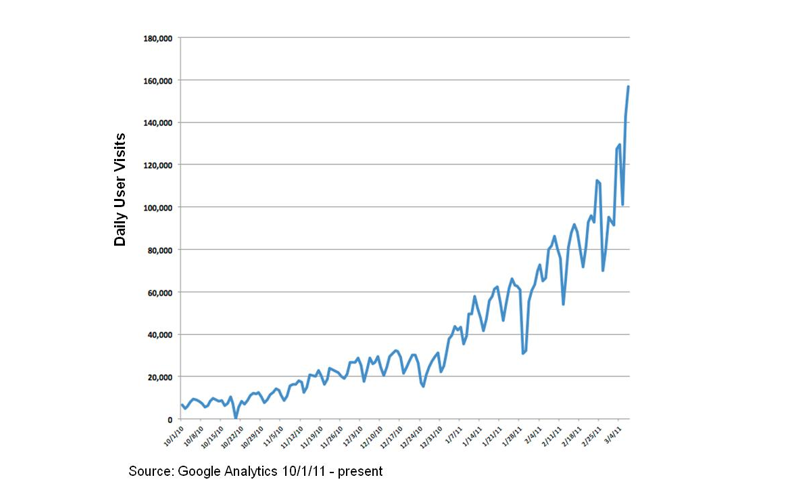
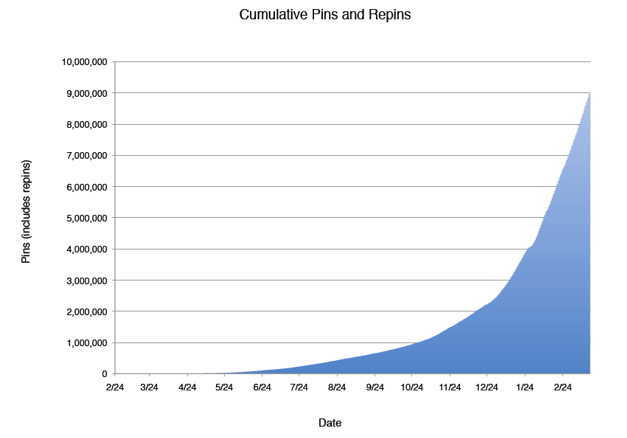
As previously mentioned, this growth has come with no spend in marketing. In fact, the founders have held back the community’s growth with a limited beta in order to ensure they create a core community on the site before they open the registration process. The efforts seem to be working. Thus far, 74% of Pinterest’s visitors return to the site, and of those that return, visitor loyalty has been extremely impressive:
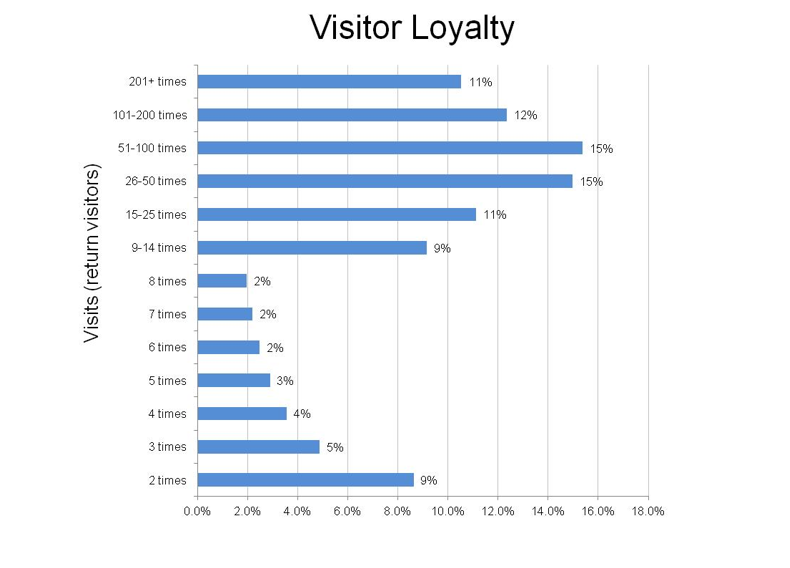
Business Model
Pinterest has not yet developed a business model and is not currently monetizing any of its traffic. Although this is one of the biggest risks for our investment, given Pinterest’s focus on products, we believe there are a number of different ways in which Pinterest could monetize. The most obvious way is by becoming an affiliate for all merchants that have products pinned on Pinterest. But we think there’s potential to create a marketplace which will let online retailers essentially bid on a CPC basis for clicks on the site, similar to how shopping comparison sites monetize. Unlike shopping comparison sites, however, Pinterest acquires all its traffic for free and because it wouldn’t be forcing merchants to compete on end-user prices, the clicks it delivers will be a lot more valuable than comparison shopping clicks. As a point of reference, Shopping.com (owned by eBay) does approximately $200 million in annual revenues with about 72 million monthly page views worldwide.
Competition
Svpply / TheFancy: Svpply and TheFancy are the two closest competitors that we know. Both are New York City-based companies with similar functionality, talented founders but a different design aesthetic. Beginning in January 2011, Pinterest started to pull away from these players and emerged as a clear leader with more than 10x the pageview traffic and the reach differential shown here:
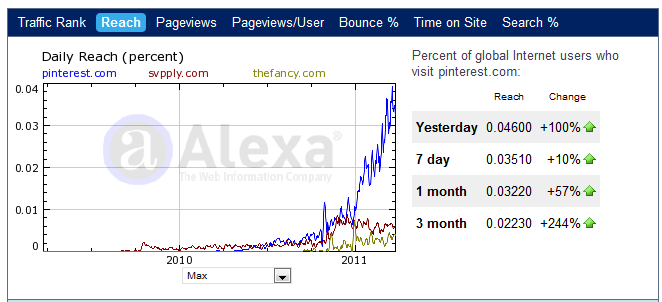
Facebook: Facebook has functionality that lets users “like” products on certain eCommerce sites via Facebook connect. Manufacturers set up fan pages on Facebook (e.g., http://www.facebook.com/huggies) where they aggregate comments and “Likes” from Facebook. We think Pinterest’s functionality and product “social graph” is unique and not easily replicated in Facebook, but Facebook dominates social and already has strong relationships with manufacturers, so they remain a competitive threat.
BazaarVoice: BazaarVoice is a bit of a dark horse in social eCommerce. It powers the majority of product reviews on eCommerce sites and has millions of consumers registered in its system. Thus far, all of its efforts have been focused on building decentralized social eCommerce communities on eCommerce vendors’ sites, but BV could choose to create more of a centralized community similar to Pinterest.
Amazon: Amazon dominates eCommerce in the US and also has one of the deepest and broadest collections of product reviews on the web. These product reviews come from a community of passionate reviewers. Many of Amazon’s reviewers have written thousands of product reviews (http://www.amazon.com/review/top-reviewers) and engage in community features like an active forum on Amazon.com. Consumers can also create curated lists of products (Amazon Listmania). This feature is a bit hidden, and in fact, the top links in Google for Amazon Listmania are broken, suggesting Amazon isn’t focused on lists. That said, Amazon has a huge audience of buyers and a great community of reviewers with which to seed a competitive community of curators.
Team
Pinterest was founded by Ben Silbermann and Paul Sciarra. The two met while at Yale from which they received undergraduate degrees in 2003.
Ben Silbermann (co-founder): After college, Ben joined the Corporate Executive Board, an infrastructure and IT consulting firm that works directly with CIOs of Fortune 1000 companies. After three years, he joined Google’s AdSense team, where he was a product specialist and was responsible for analyzing product usage data and using that to inform AdSense’s product roadmap (this training is probably what helped the company notice the social sharing data in Tote and pivot to Pinterest). Ben is the product visionary here.
Paul Sciarra (co-founder): After college, Paul spent three years at Radius Ventures, a VC firm specializing in medical devices. He left Radius in August 2008 to start Tote with Ben. Our sense is that Paul has also had a hand in the company’s product design but is more focused on early business and administrative issues (e.g., fund raising).
Deal
We have signed a term sheet to lead a $10m Series A investment at a $40m pre-money valuation, inclusive of a 13% post-money option pool. Previously, the company raised just under $2m in seed capital from a handful of angels, Highline Ventures (a seed fund started by Shana Fischer of IAC), and FirstMark Capital. We would get a board seat along with one for each of the two founders.
Post-closing, the company may facilitate a buy-back of shares from early, non-employee investors. The buy-back will be at a ~25% discount to the Series A price; we may, in turn, have an option to purchase up to $2m of additional Series A shares to increase our ownership. We haven’t yet tested the waters with the early investors, so we don’t know the potential available here, but we’d like to request up to $10m of investment from BVP.
Risks
Monetization: As already noted, Pinterest does not have a developed business model. In order for Pinterest to build a valuable company long term, it will have to find a scalable business model that doesn’t negatively impact the consumer experience.
Consumer Adoption: Pinterest’s consumer traction thus far is promising, but it will need to grow substantially in order to build a significant company and cross the chasm from early adopters to mainstream users.
Competition: Pinterest already has two competitors in the space with very similar product offerings, and more are sure to follow (how many high profile mobile photo sharing startups are there now?). Pinterest must also navigate the constant potential threat from Facebook should it decide to compete.
Team: It’s only five people at this point! Thus far, we’ve been really impressed by Ben and Paul, but they are both first-time entrepreneurs and relatively inexperienced managers. Moreover, neither of them is deeply technical, and the site is already having trouble scaling. They’ll need a complement in the form of a strong CTO/VPE and broader bench of technical talent.
Scenario Analysis
This scenario assumes the $10m round described in the deal section ($8.6 from BVP, $1.4m from insiders) plus an extra $1m from BVP to facilitate a discounted buy-back from early angels. So, the net amount invested into the company will be $10m, but there would be $11m of new preferences (in addition to the $2m of preferences from capital already raised).
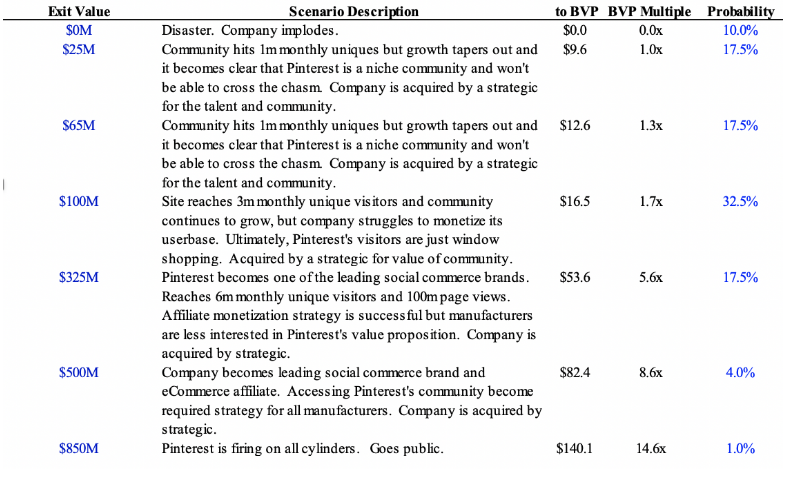
Conclusion
Pinterest represents an opportunity to invest in a talented early stage team with noteworthy traction against what could be a very large and compelling business. Despite the expensive price and the inherent early stage risks, we are bullish on this opportunity and recommend this investment.
